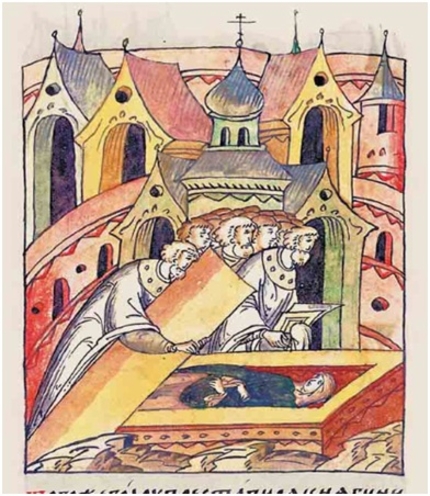
Maria (Agafia, Agatha) Mstislavna (born in 1185-1189 — † January 24, 1221 in Rostov), from 1216 — Grand Duchess of Vladimir.
Father
- Mstislav Romanovich of Kiev (the Old)
Biography
Maria was daughter of the Smolensk prince Mstislav Romanovich the Old. She was born between 1185 and 1189 [1, p. 476; 5] At the age of ten, she was brought from Smolensk to Vladimir for a marriage to the son of Vsevolod the Big Nest, Konstantin of Rostov. According to L. E. Morozova, Maria-Agafia was educated in the family of her future husband, under the influence of her future mother-in-law Maria of Vsevolozhsk (Shvarnovna) [3, p. 479]. After the marriage with Konstantin of Rostov and the birth of their first child, Maria moved with her husband to Rostov which Constantine received as appanage (udel). P. A. Rappoport notices that it was with her procuration that the Assumption Cathedral was restored and the Church of Constantine and Helena was built [4, p. 58-60]. Intensive construction activities in Vladimir continued even when Konstantin Vsevolodovich has become Grand Duke of Vladimir [I, p. 419].
The secular name of the duchess — Maria —remained unknown for a long time, for the chronicles always referred to her with her monastic name, Agafia [I, p. 419-421], which she adopted after the death of Konstantin. It was only in 2017 that the name of the duchess was identified by the Yaroslavl archaeological expedition led by A.V. Engovatova. During the excavations, a seal with the image of St. Mary was discovered; it served obviously to seal important legal documents confirming property transactions. It is highly likely, that the seal belonged to Maria as it was established by P. G. Gaidukov [2]. The very existence of such a seal is an indication of a high status and the ability to arrange important transactions with real estate. All of that allows to conclude that Maria-Agafia was a rich land-owner. Maria thus led a rather active life. L. E. Morozova believes that the princess actively supported her husband in the struggle for power after the death of Vsevolod the Big Nest in 1212 and that it was with her father’s help that Konstantin succeeded to occupy ascend to the grand-ducal throne [3, p. 480]. After Konstantin’s death in 1218, Maria took monastic vows and a new religious name Agafia and retreated with her sons to Rostov. The nun outlived her husband by four years and even wrote a historical work about him; the text would later be included into the Laurentian Codex [I, p. 420-421; 3, p. 480]. According to the Trinity Chronicle, Agafia was buried in the Assumption Cathedral in Rostov [II, p. 306].
Children
- St. Vasilko (canonized) (1209-1238)
- Vsevolod (1210-1238)
- Vladimir (1214-1249)
Information
A seal with an image of St. Mary, which belonged to Maria, wife of the Grand Duke of Vladimir Konstantin Vsevolodovich [2].
Sources
I. Polnoe sobranie russkikh letopisei (PSRL). T. 1. Lavrent'evskaia letopis'. Riazan', 2001.
II. Priselkov M.D. Troitskaia letopis'. Rekonstruktsiia teksta / Pod red. i s predisl. K.N. Serbinoi. M.; L., 1950.
Bibliography
1. Dombrovskii D. Genealogiia Mstislavichei. Pervye pokoleniia (do nachala XIV v.) / Per. s pol'skogo i vstup. slovo k rus. izd. K. Iu. Erusalimskogo, O. A. Ostapchuk. SPb, 2015.
3. Morozova L.E. Velikie i neizvestnye zhenshchiny Drevnei Rusi. M, 2009.
4. Rappoport P.A. Russkaia arkhitektura Kh–KhII vv. L., 1982.
Links
1. Генеалогии правивших семейств России и Европы
http://expositions.nlr.ru/LaurentianCodex/_Project/page_Show.php
